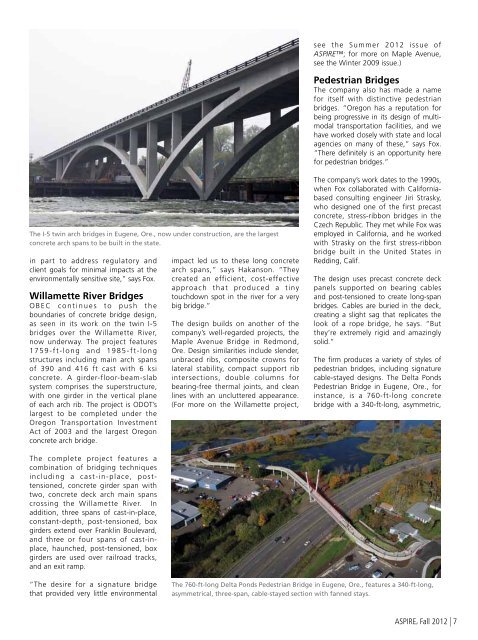ASPIRE Fall 2012 - Aspire - The Concrete Bridge Magazine
ASPIRE Fall 2012 - Aspire - The Concrete Bridge Magazine
ASPIRE Fall 2012 - Aspire - The Concrete Bridge Magazine
Create successful ePaper yourself
Turn your PDF publications into a flip-book with our unique Google optimized e-Paper software.
see the Summer <strong>2012</strong> issue of<br />
<strong>ASPIRE</strong>; for more on Maple Avenue,<br />
see the Winter 2009 issue.)<br />
Pedestrian <strong>Bridge</strong>s<br />
<strong>The</strong> company also has made a name<br />
for itself with distinctive pedestrian<br />
bridges. “Oregon has a reputation for<br />
being progressive in its design of multimodal<br />
transportation facilities, and we<br />
have worked closely with state and local<br />
agencies on many of these,” says Fox.<br />
“<strong>The</strong>re definitely is an opportunity here<br />
for pedestrian bridges.”<br />
<strong>The</strong> I-5 twin arch bridges in Eugene, Ore., now under construction, are the largest<br />
concrete arch spans to be built in the state.<br />
in part to address regulatory and<br />
client goals for minimal impacts at the<br />
environmentally sensitive site,” says Fox.<br />
Willamette River <strong>Bridge</strong>s<br />
OBEC continues to push the<br />
boundaries of concrete bridge design,<br />
as seen in its work on the twin I-5<br />
bridges over the Willamette River,<br />
now underway. <strong>The</strong> project features<br />
1759-ft-long and 1985-ft-long<br />
structures including main arch spans<br />
of 390 and 416 ft cast with 6 ksi<br />
concrete. A girder-floor-beam-slab<br />
system comprises the superstructure,<br />
with one girder in the vertical plane<br />
of each arch rib. <strong>The</strong> project is ODOT’s<br />
largest to be completed under the<br />
Oregon Transportation Investment<br />
Act of 2003 and the largest Oregon<br />
concrete arch bridge.<br />
impact led us to these long concrete<br />
arch spans,” says Hakanson. “<strong>The</strong>y<br />
created an efficient, cost-effective<br />
approach that produced a tiny<br />
touchdown spot in the river for a very<br />
big bridge.”<br />
<strong>The</strong> design builds on another of the<br />
company’s well-regarded projects, the<br />
Maple Avenue <strong>Bridge</strong> in Redmond,<br />
Ore. Design similarities include slender,<br />
unbraced ribs, composite crowns for<br />
lateral stability, compact support rib<br />
intersections, double columns for<br />
bearing-free thermal joints, and clean<br />
lines with an uncluttered appearance.<br />
(For more on the Willamette project,<br />
<strong>The</strong> company’s work dates to the 1990s,<br />
when Fox collaborated with Californiabased<br />
consulting engineer Jiri Strasky,<br />
who designed one of the first precast<br />
concrete, stress-ribbon bridges in the<br />
Czech Republic. <strong>The</strong>y met while Fox was<br />
employed in California, and he worked<br />
with Strasky on the first stress-ribbon<br />
bridge built in the United States in<br />
Redding, Calif.<br />
<strong>The</strong> design uses precast concrete deck<br />
panels supported on bearing cables<br />
and post-tensioned to create long-span<br />
bridges. Cables are buried in the deck,<br />
creating a slight sag that replicates the<br />
look of a rope bridge, he says. “But<br />
they’re extremely rigid and amazingly<br />
solid.”<br />
<strong>The</strong> firm produces a variety of styles of<br />
pedestrian bridges, including signature<br />
cable-stayed designs. <strong>The</strong> Delta Ponds<br />
Pedestrian <strong>Bridge</strong> in Eugene, Ore., for<br />
instance, is a 760-ft-long concrete<br />
bridge with a 340-ft-long, asymmetric,<br />
<strong>The</strong> complete project features a<br />
combination of bridging techniques<br />
including a cast-in-place, posttensioned,<br />
concrete girder span with<br />
two, concrete deck arch main spans<br />
crossing the Willamette River. In<br />
addition, three spans of cast-in-place,<br />
constant-depth, post-tensioned, box<br />
girders extend over Franklin Boulevard,<br />
and three or four spans of cast-inplace,<br />
haunched, post-tensioned, box<br />
girders are used over railroad tracks,<br />
and an exit ramp.<br />
“<strong>The</strong> desire for a signature bridge<br />
that provided very little environmental<br />
<strong>The</strong> 760-ft-long Delta Ponds Pedestrian <strong>Bridge</strong> in Eugene, Ore., features a 340-ft-long,<br />
asymmetrical, three-span, cable-stayed section with fanned stays.<br />
<strong>ASPIRE</strong>, <strong>Fall</strong> <strong>2012</strong> | 7

















